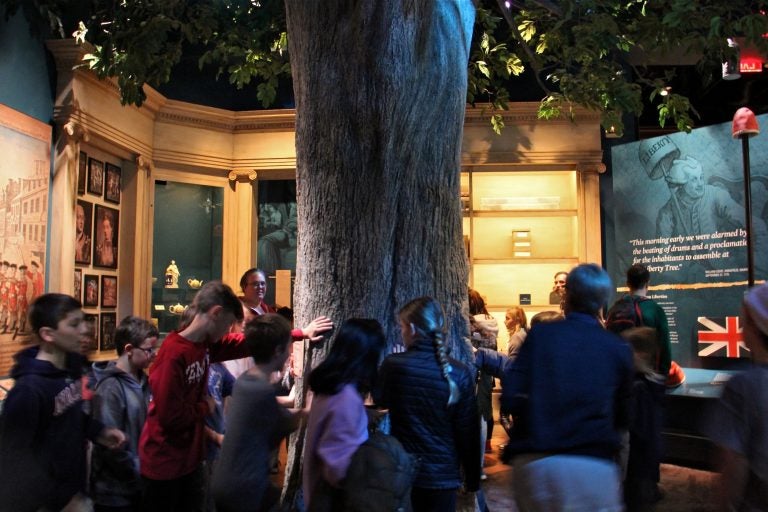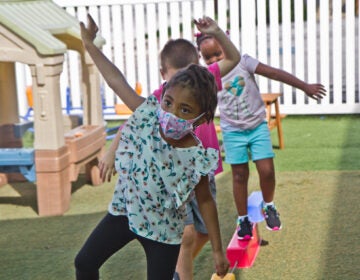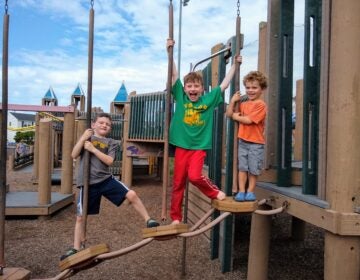Region’s cultural attractions develop resources for sensory-sensitive visitors
Various companies offer consultation and accreditation to museums for their ability to welcome people with sensory sensitivities.

The exhibit room that houses the Liberty Tree at the Museum of the American Revolution is softly lit and full of tactile experiences, but the hubbub can be too much for some children with autism. (Emma Lee/WHYY)
The Museum of the American Revolution in Philadelphia is immersive: It attempts to explain why and how the Revolutionary War happened by re-creating events through a series of tableaus that brings the war to life.
One room has the sound of gunfire coming up through speakers in the floor. Another room puts you on the front line of the Battle of Brandywine — as the doors close behind you, the British invade from a 180-degree projection, with simulated explosions all around.
“For many guests, that’s very evocative,” said Tyler Putman, the museum’s gallery interpretation manager. “But for others, that can be overwhelming and overstimulating.”
The Museum of the American Revolution is part of a growing trend among cultural attractions to accommodate people with sensory sensitivities. Most typically, these are children on the autism spectrum, but they also can include people with conditions such as PTSD or dementia.
Sensory sensitivities cover a broad range and often are not consistent from person to person. They can include an intolerance to bright light and loud noises, an aversion to strong smells, a fear of crowds in small spaces, or a dislike of touching and being touched.
“We offer noise-canceling headphones,” Putnam said. “We offer all of our films on an iPad that you can view in a quiet room, so you don’t have to stand in a crowded theater to watch them.”
Quiet rooms are available for people who find themselves reacting negatively to the exhibitions. This month, the museum will pilot special days when it will lower its lighting and quiet its speakers, essentially muting itself. Also, the museum’s staff is trained in working with people with sensitivities.
“Some people with disabilities prefer not to be recognized. They’d rather not be treated any different or expect me to recognize that,” Putnam said. “What the training did for our staff was, if they are able to identify, or if someone self-presents as being on the autism spectrum, ways to engage and assist that person.”
The museum sought out advice and ultimately certification from the International Board of Credentialing and Continuing Education Standards (IBCCES). The board is part of an expanding industry of organizations that establish a set of standards for places like schools, sports venues, cultural attractions, and medical clinics to recognize and support people with sensory sensitivities.
“The certification is something a lot of folks connect to because it has teeth, so to speak,” said Meredith Tekin, the board’s president. “It is an actual process you can follow, and there are requirements for updated training. It’s an ongoing commitment.”
The board has been consulting and accrediting business in autism sensitivity for two decades, mostly in the health care, law enforcement, and education fields. Only recently has it extended to cultural attractions.
The International Board of Credentialing and Continuing Education Standards is not the only game in town, however. Recently, the Zimmerli Art Museum at Rutgers University, New Brunswick, consulted with KultureCity, an Alabama-based training organization that has worked with sports stadiums to make them more accommodating to people with autism.
Just like the Museum of the American Revolution, the Zimmerli Museum can provide visitors with a sensory kit that includes headphones, a fidget toy to keep anxious fingers busy, and maps of the building that identify locations with possible sensory triggers.
Those places also have signs to inform visitors that sensory accommodations are available, quiet rooms and websites with social stories.
“A social story is primarily a photo-driven narrative that lets the individual know what coming to this venue will be like,” said the Zimmerli’s education curator, Amanda Potter. “This is what the front door looks like; this is what the front desk looks like. It’s all about informing the individual ahead of time, so they will not be surprised and have a negative reaction to what most of us take for granted.”
Although the Americans with Disabilities Act requires all businesses and public spaces to comply with certain accessibility standards — such as wheelchair accessibility and anti-discriminatory laws — there is no legal requirement to provide resources to people with sensory sensitivities.
For locations that choose to offer accommodations to people with sensory sensitivities, organizations like KultureCity and International Board of Credentialing and Continuing Education Standards offer not only consultation but their own proprietary stamp of approval, one that implies a set of common standards have been met.
“A lot of individuals in the autism community are wary of phrases like ‘autism-friendly’ or ‘sensory-friendly’ because that means something different to everybody,” Tekin said, discussing IBCCES certification. “Does that mean you give a donation? Does that mean you have accommodations? Does that mean a discount on Tuesday? The credential gives reference points and a formal standard.”
Not all cultural attractions seek official accreditation from private consulting businesses. The Franklin Institute and the Please Touch Museum, for example, have both developed accommodations based on internal research.
The Franklin Institute, on Philadelphia’s Benjamin Franklin Parkway, is a hands-on science museum whose noise level can be deafening when it’s filled with hundreds of energetic children. Since 2011, it has been considering ways to best serve visitors on the autism spectrum.
“We had learned this is a trend, that people were realizing it was a need. It piqued our interest,” said Gerri Trooskin, the Franklin’s director of museum programs and outreach initiatives. “We started looking locally and nationally at what was happening in the field, and taking our cues and learning best practices.”
The Franklin Institute consults with the occupational therapy department of nearby Salus University to develop its sensory sensitivity tools. Trooskin said that right now, it is not seeking any official accreditation from an outside agency.
Both the Franklin Institute and the Please Touch Museum have come up with accommodations consistent with the other places: noise-canceling headphones, fidget toys, quiet rooms, sensory maps, and scheduled “relaxed” museum days.
How they are applied is case-by-case.
“Autism is such a wide-ranging disorder. There are so many behaviors that can be part of it. There is no stereotypical autistic individual,” said Potter from Zimmerli. “Part of what these institutions are doing is mak[ing] information available, and families can make decisions about what is right for them.”
WHYY is your source for fact-based, in-depth journalism and information. As a nonprofit organization, we rely on financial support from readers like you. Please give today.






